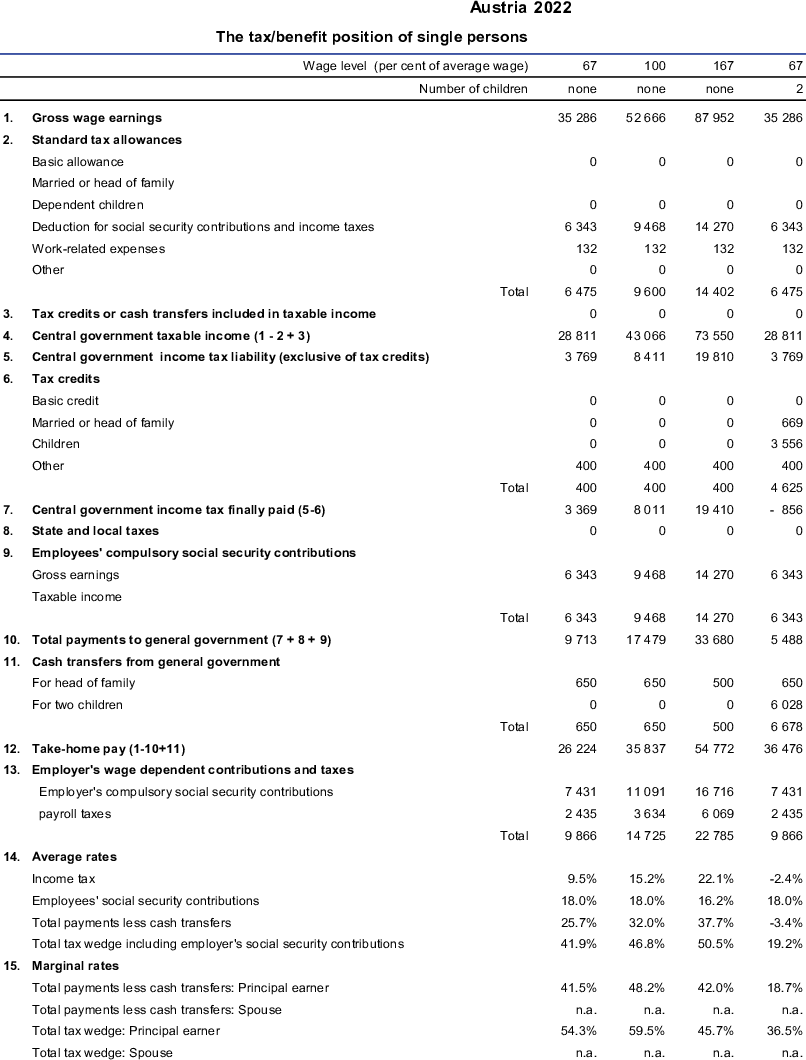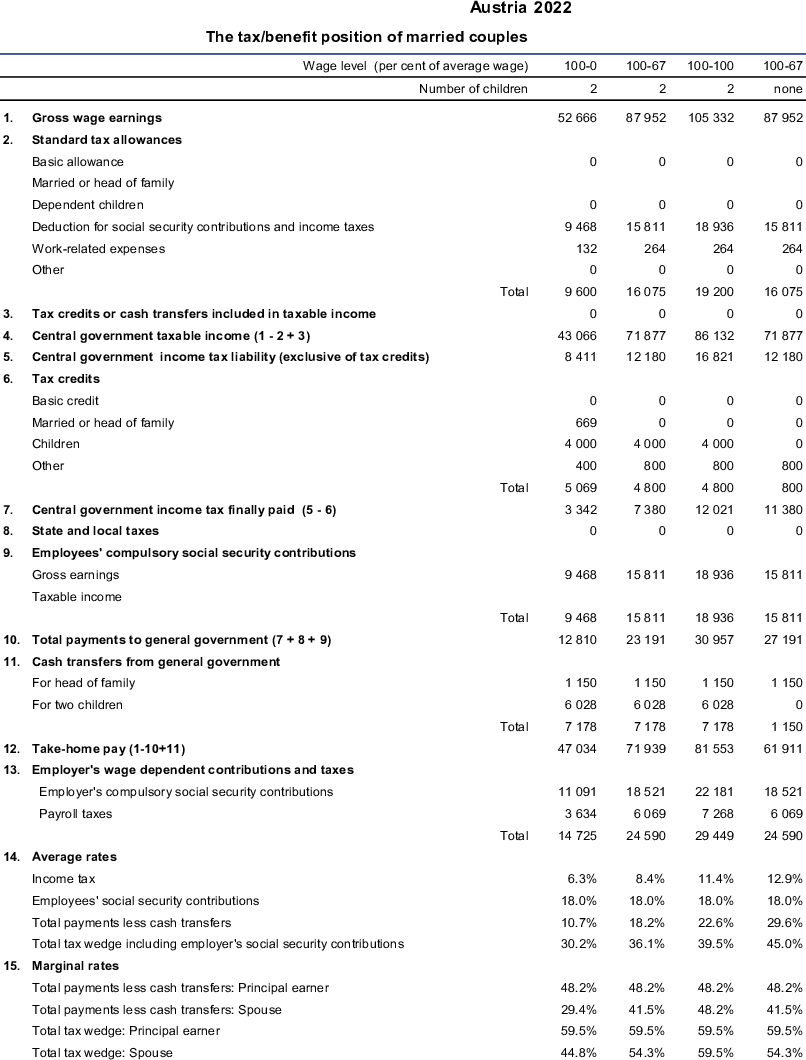In 2004, the first step of a comprehensive tax reform came into force. The general tax credit was increased from EUR 887 to EUR 1 264 and the phasing-out rules were considerably simplified and harmonized for all groups of taxpayers.
The tax reform in 2005 brought a new income tax schedule. Apart from the top rate of 50% for incomes exceeding EUR 51 000, it shows the average tax rate for two amounts of income. The tax amounts for incomes between these values have to be calculated by linear interpolation. The formulas that have to be applied are defined in the tax law. The tax reform included some measures which were made retrospective for 2004. These measures are an increase of the sole earner and the single parent tax credit depending on the number of children (together with a higher income limit for the spouse of a single earner) and an increase of traffic reliefs by about 15%. The maximum deductible amount for church contributions was increased as well. In 2006, the traffic reliefs were raised again by about 10%.
In 2007, the traffic allowance was increased by 10% (effective from 1st July). Additionally, the maximum negative tax for employees with traffic allowances was raised from EUR 110 to EUR 240 (for 2008 and 2009). In 2008, the family allowance for the third child and all subsequent children was increased. Furthermore, the unemployment insurance contribution of low-earning employees was reduced (effective from 1st July). Also in 2008, for monthly earnings up to EUR 1 100 the rate was set to zero, for earnings below EUR 1 200 the contribution was set to 1%, below EUR 1 350 2% and above it was set to the current rate of 3%. Since 2008, these income limits have been raised according to the increase of the ceiling levels of social security contributions every year.
In September 2008, the parliament decided some measures to compensate for the strong increase of food and energy prices: inter alia, the tax exemption of overtime supplements was increased and the 13th child allowance was introduced.
The tax reform 2009 (effective from the 1st of January) brought an increase of the zero bracket (from EUR 10 000 to EUR 11 000), a reduction of the marginal income tax rates (except the top rate), an upward shift of the top rate bracket (from EUR 51 000 to EUR 60 000) and several measures for families with children: child allowance (EUR 220 or EUR 132 each parent p.a.), deductibility of cost for child care (up to EUR 2 300 p.a. per child), tax-free payments (up to EUR 500 p.a.) from employers to their employees for child care and an increase of the child tax credit.
Starting in 2013 a progressive rate schedule is applied to Christmas and leave bonus instead of a flat rate regime of 6% (see 1.1.3.)
The tax reform 2016 decreased all marginal tax rates significantly, notably the marginal tax rate of the first tax bracket, which was reduced by 11.5 percentage points from 36.5% to 25%. Limited to the years 2016 to 2020 the top marginal tax rate is temporarily increased by 5% points to 55%. These 55% apply to those parts of income exceeding EUR 1 million a year.
The tax credit for employees was increased from EUR 345 to EUR 400. The non-wastable tax credit (reimbursement of social security contributions) for low earnings was extended. For employees the non-wastable tax credit was increased to a maximum of 50% of social security contributions up to a ceiling of EUR 400 a year. For commuters eligible for the commuter tax allowance the maximum amount of the non-wastable tax credit is EUR 500. This system of a non-wastable tax credit was extended to pensioners too, limited to EUR 110.
Besides the already existing broad financial support for families (payable tax credit and transfers as well as deductibility of cost for child care) the tax reform 2016 increased the tax allowance for children from EUR 220 to EUR 440 per child. If both parents claim for this tax allowance, it increases to EUR 600 (two times EUR 300).
Tax expenditures (tax allowances) for private insurances (e.g. health and pension insurances) and mortgages were abolished for new contracts beginning with 2016. For existing contracts these tax allowances are maintained for a transitional period of five years.
In 2019 a non-payable family tax credit of EUR 1 500 each child (EUR 500 if the child is older than 18 years) was introduced. The parents can split up the tax credit one half each. Sole- or single-earner with low income, who cannot fully participate on that non-payable family tax credit, can apply for a payable sole- or single-earner family tax credit up to EUR 250 each child.
In 2020 the positive entrance rate of the tax rate schedule was reduced to 20% and the refund of social security contributions for low earners was increased.
From 2021 on, the standard tax allowance for special expenses of EUR 60 was abolished.
From 2022 on, the supplement to the traffic tax credit is raised from EUR 400 to EUR 650. In case of a negative income tax liability, the refund is capped at 55% of overall social security contributions paid or a maximum of EUR 550.
The non-payable family tax credit is increased to EUR 2000 for each child (EUR 650 if the child is older than 18 years). From now on the maximum amount payable by child via the so-called `Kindermehrbetrag’ is EUR 550. Also the definition of eligible recipients has been expanded and is not limited anymore to qualifiers for sole- or single earner tax credits.
Several new (mostly one-time) tax credits and cash transfers have been introduced:
An inflation tax credit of EUR 500 that is faded out uniformly to zero for current income between EUR 18 200 and EUR 24
500. In case of a negative income tax liability, the refund for 2022 is limited to 70% of overall social security contributions paid (max. refundable amount: EUR 1 550).
The `climate bonus’: direct, tax-free lump-sum payment of EUR 250 per person. Children up to the age of 18 years receive half the amount. The stated amount applies only for 2022.
A one-time supplement to the climate bonus (the anti-inflation bonus). Payment of EUR 250 that is tax-exempt up to a yearly taxable income of EUR 90 000. Again, for children only EUR 125 are paid.
An energy cost credit worth EUR 150 (only for households with adjusted gross annual income of EUR 55 000 (single household) or EUR 110 000 (multiple earners)). This cash transfer is a one-time measure to counteract risen energy prices.


